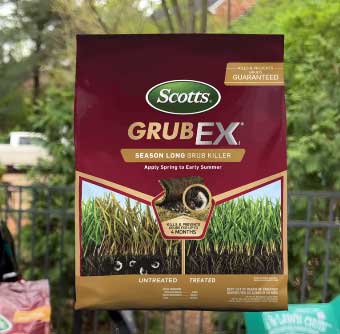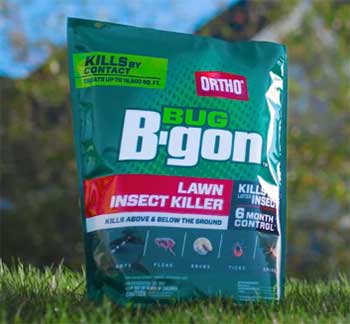As a homeowner, keeping your lawn healthy and green is a top priority. But those aspirations can quickly turn to headaches when grubs invade and start munching on your grass roots.
Heavy grub damage leads to dead patches and thinning turf, so control is essential.
When it comes to preventing and treating grubs, two products stand out as top options: GrubEx and Bug B Gon. But which one is right for your yard? Let’s take an in-depth look at how these grub killers compare.
A Brief Comparison Table
| Feature | GrubEx | Bug B Gon |
| Active Ingredient | Chlorantraniliprole 0.08% | Trichlorfon 9% |
| Mode of Action | Systemic, residual | Contact only |
| Application Timing | Early spring or summer (preventive), late summer to early fall (curative) | Summer to fall (curative only) |
| Treatment Area | 5,000 sq. ft. per bag | 2,000-8,000 sq. ft. per bottle |
| Residual Control | Up to 4 months | None |
| Grub Life Stages Controlled | Young grubs to late instars | Only mature grubs |
| Cost per Application | $0.01/sq. ft. | $0.004-$0.0125/sq. ft. |
| Reapplication Need | Once per year | Possibly multiple if grubs return |
| Toxicity | Low, with precautions | Moderate, avoid inhalation |
What Are Grubs?
Before diving into the products, it helps to understand exactly what grubs are and how they damage lawns. Grubs are the larval form of beetles, including species like Japanese beetles, June beetles, European chafers, and masked chafers.
The adults lay eggs in lawns which hatch into C-shaped grubs with six legs that live in the soil.
These pests feed on the roots of grass, chewing away at the vital structures the plant needs to survive. As feeding increases in late summer and fall, grass roots can get devoured to the point of causing dead brown patches. If grub populations are high, entire sections of lawn may die.
Getting rid of grubs requires killing them in the soil before they can destroy your precious turf. That’s where preventive and curative grub control products come in. Let’s see how two popular options, GrubEx and Bug B Gon, compare when it comes to wiping out grubs.
Key Differences Between GrubEx And Bug B Gon
- Active Ingredients
The first distinction between these two grub killers is their active ingredients. This determines how they work to control grubs.
GrubEx

The active ingredient in GrubEx is chlorantraniliprole 0.08%.
This belongs to the anthranilic diamide class of insecticides.
It is absorbed by the roots and moves systemically throughout the grass plant.
When grubs feed on the grass roots, they ingest the insecticide.
It binds to their muscle cells, causing paralysis and eventual death.
In this way, it provides excellent curative grub control for existing infestations.
Chlorantraniliprole also provides residual activity in the soil for up to 4 months to kill newly hatched grubs before they can damage roots. This preventive action reduces the risk of future grub damage.
Overall, chlorantraniliprole provides efficient control with low mammalian toxicity.
Bug B Gon
Bug B Gon contains the active ingredient trichlorfon 9%. This organophosphate insecticide works differently than GrubEx.
Instead of moving systemically through the plant, trichlorfon kills grubs on direct contact in the soil. It inhibits an enzyme called cholinesterase, causing overstimulation of the nervous system.
While this product offers curative control of existing grubs, it provides very little residual activity. It will only kill grubs that are physically exposed to the insecticide. There is no lasting preventive control.
Trichlorfon also poses moderate toxicity risks to humans and pets when used improperly. It’s now banned in many countries.
Based on the active ingredients, GrubEx provides superior grub control through systemic and residual activity not achieved by Bug B Gon.
- Application
The application process is another major difference between GrubEx and Bug B Gon:
GrubEx
GrubEx is designed for preventive grub control before damage occurs. It should be applied in spring or early summer before grubs hatch. This allows time for the insecticide to move through the grass roots.
It can be sprayed with a hose-end sprayer or spread with a broadcast spreader. For optimal results, lightly water after application to move the product into the root zone.
To treat existing grub infestations, GrubEx works best when applied from late summer through early fall when grubs are young. This allows active ingredients to get absorbed by roots before major root feeding occurs.
Bug B Gon
Bug B Gon is primarily a curative treatment for active grub infestations. It should be applied when grubs are detected through soil sampling, usually in late summer or fall.

The product is mixed with water and needs to be sprayed over the lawn using a tank sprayer or hose-end sprayer.
Thorough coverage of all affected areas is key for contact with grubs in the soil.
Unlike GrubEx, Bug B Gon does not offer any residual or preventive activity.
Any grubs that hatch after application will not be controlled.
Overall, GrubEx offers more flexibility and effectiveness as both a preventive and curative grub treatment.
Bug B Gon requires precise timing and thorough application to successfully kill existing grubs.
- Treatment Area
When comparing grub control products, it’s also useful to consider how much yard they can treat:
GrubEx
A standard 15 lb. bag of GrubEx covers up to 5,000 sq. ft. This makes it a great choice for treating average-sized yards. Those with larger lawns may need multiple bags.
Since GrubEx works preventively, it only needs to be applied once per year prior to grub season. One application provides season-long control.
Bug B Gon
The Bug B Gon concentrate makes up to 16 gallons of finished spray. Depending on the rate used, that’s enough to treat between 2,000-8,000 sq. ft.
However, since Bug B Gon lacks any residual activity, treatment may be required multiple times in a season if grubs reappear. This increases the amount of product needed compared to GrubEx.
When comparing coverage, GrubEx gives you more mileage from a single application. It allows preventive treatment of moderately-sized lawns cost-effectively.
- Cost Comparison
When weighing grub control options, the cost is often a deciding factor. Here’s how GrubEx and Bug B Gon compare:
GrubEx
A 15 lb. bag of GrubEx costs $40-$60 on average from home improvement stores, garden centers, or online. This single application treats up to 5,000 sq. ft for the whole season.
It costs around $0.01/sq. ft. For a 5,000 sq. ft lawn, that’s $50 per year for preventive and curative grub control.
Bug B Gon
A 32 oz. concentrate bottle of Bug B Gon costs $15-$25 per bottle. This makes 8-16 gallons of finished spray, covering 2,000-8,000 sq. ft.
The cost can range from $0.004-$0.0125/sq. ft. depending on the dilution rate. Treating 5,000 sq. ft at the high rate costs around $62.
But remember, Bug B Gon may require repeat applications if grubs return the same year. That can quickly drive up costs compared to the one annual application of GrubEx.
Overall, GrubEx provides the most cost-effective protection when you account for the labor and product needed for whole season control.
Safety Precautions
When using any pesticide products, following label directions and taking proper safety measures is critical. Here are the key precautions for these grub killers:
GrubEx
- Keep children and pets off treated areas until product has been watered in and lawn is dry
- Wear gloves, long sleeves, and pants when handling the granules
- Avoid contact with eyes, skin, or clothing
- Do not apply near water bodies or storm drains
- Rinse applicator thoroughly after use
Bug B Gon
- Keep people and pets away from the area during application
- Do not allow people or pets onto treated areas until spray has dried
- Wear a long-sleeved shirt, long pants, socks, shoes, and chemical-resistant gloves
- Avoid contact with eyes, skin, or clothing
- Avoid inhaling spray mist
- Rinse sprayer equipment thoroughly after use
Always defer to the product labels for complete safety instructions. Both products are low in toxicity when label directions are followed, but common sense precautions should be taken.
Effectiveness Comparison
Now that we’ve covered all the key factors, let’s summarize how these two products stack up against grubs:
GrubEx
- Offers preventive and curative control
- Systemic and residual activity for lasting protection
- Flexible application timing
- Single annual application
- Treats average-sized yards economically
Bug B Gon
- Only controls existing grubs on contact
- No residual or preventive control
- Must be applied when grubs active
- May require repeat applications
- Higher cost for whole season control
The Winner: GrubEx
Based on the insecticide properties, application methods, safety, and costs, GrubEx is the clear winner compared to Bug B Gon for comprehensive, long-lasting grub control.
The systemic and residual activity of GrubEx provides season-long protection, both preventing and wiping out grubs in all life stages. It’s effective, economical, and reliable.
While Bug B Gon can help knock down active grub populations, it doesn’t offer the preventive power or convenience of GrubEx.
If you want to nip grubs in the bud before they take over your lawn, GrubEx is the top choice for grub control.
Frequently Asked Questions About Grub Control
Still have some questions about choosing and using grub killers? Here are answers to some commonly asked questions:
Based on its systemic and residual activity, GrubEx is the most effective product for complete grub control. It both prevents and kills grubs before they damage your lawn.
Other products containing chlorantraniliprole, like Scott’s GrubEx1, offer similar preventive and curative control as GrubEx. Bayer Advanced 24 Hour Grub Killer Plus also provides residual activity but is less cost effective.
GrubEx targets grubs in their larval stage, including Japanese beetle grubs, masked chafer grubs, European chafer grubs, Oriental beetle grubs, and more. It kills newly hatched grubs as well as larger grubs up to late instars.
Apply GrubEx in spring or early summer (April-June) before grubs hatch. In southern lawns, use the earlier window from March-April. For curative control, apply when grubs are young in August-September.
Final Thoughts
If your lawn has faced past grub damage or you want to protect your turf early, don’t wait – take action now with an effective grub killer like GrubEx. Its lasting, dual-action control knocks out grubs and keeps them from coming back all season long.
With a single spring application, you can check grubs off your lawn care to-do list and ensure your grass stays lush and healthy. Don’t let grubs destroy the lawn you’ve worked so hard to maintain. GrubEx has your back.

Hi Ralph, real well written. I’m convinced to use GrubEx in the spring, but wonder if grubs that have done damage this year will contribute more damage before March. We’re in NC and, while in the 60’s, still growing. Should I treat now (Oct 21)?
Thanks in advance.